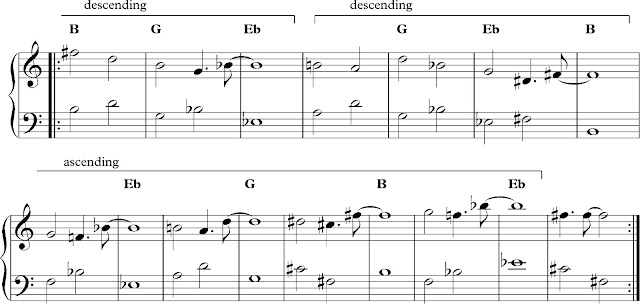It is interesting to note that Coltrane’s chromatic major
third cycle was applied compositionally and improvisationally (too sharp a
distinction should not be drawn) in both the ascending and descending directions.
Ascent and descent have accordingly different musical effects. “Giant Steps”
and an excerpt from “Venus” may serve as examples.
The first seven bars of “Giant Steps” feature two incomplete descending chromatic major third cycles which are paired with descending melodies. The remainder of the composition reverses that direction for an ascending major third cycle with rising melody.
This excerpt from “Venus” (1:33-1:57 in the video below) illustrates an instance of the
ascending major third cycle complemented by an ascending melody, followed by a major third harmonic descent with descending melody.
In both cases, the ascending third cycle is accompanied by
the feeling of an increase in tension, while the descending third cycle brings
about the feeling of a dissipation of tension. This is partly due to the rising
and falling melodies, but there is also a harmonic component to the effect of
accumulating or lessening musical tension.
In Coltrane’s music, the chromatic third cycle has harmonic
implications inherited from the principles of tonality. The ascending major third
cycle (I-III#-bVI-I) moves each harmony four ticks in the sharp-key direction
along the circle of fifths (C-G-D-A-E...). In tonal music, harmonic
movement in the sharp-key direction is associated with an increase in tension. Conversely, the descending major third cycle (I-bVI-III#-I) moves each
harmony four ticks in the flat-key direction along the circle of fifths (C-F-B-flat-E-flat-A-flat…). Shifts to the flat-key area are generally associated with
the relaxation of musical tension. In addition, the III triad contains the
leading tone and (raised) fifth, and is therefore related to the dominant chord;
whereas the bVI triad contains the tonic and (flatted) sixth, thus relating it
to the subdominant chord.
The sense of building and releasing tension in these
examples, then, is overdetermined: both melodic contour and the harmonic implications
of the third cycle play important roles in creating the effect.



No comments:
Post a Comment